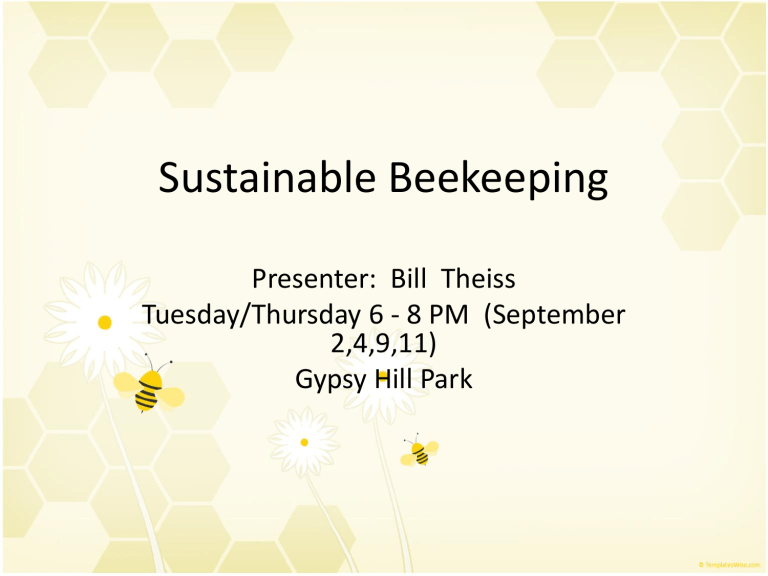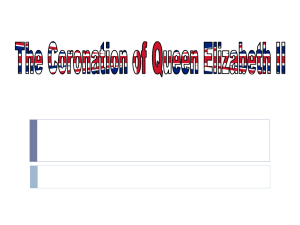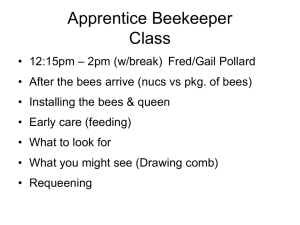Introduction to Beekeeping: What`s the Buzz?

Sustainable Beekeeping
Presenter: Bill Theiss
Tuesday/Thursday 6 - 8 PM (September
2,4,9,11)
Gypsy Hill Park
Syllabus
• Thursday – September 11
– Hive management procedures and techniques
• Exterior and interior hive inspection
• Splits and hive body rotations
• Queen rearing
• Pollen, nectar and beneficial flowers
– Honey and beeswax
• Types of honey and beeswax
• Honey harvesting, handling, packaging and storage
Honey Bees as a Superorganism
Superorganism—an entity in which its many members carry out specialized and vital functions to keep the whole functioning as a unit.
Hive Temperature Management
For healthy development, young bees must be maintained between 89.6 and 95 degrees Fahrenheit.
In contrast, adults can withstand temperatures as high
122 degrees Fahrenheit. Worker bees create heat by contracting their thoracic muscles, similar to shivering in mammals. To protect the vulnerable brood when it's hot, workers fan the comb, spread fluid to induce evaporative cooling, or – when the heat stress is localized - absorb heat by pressing themselves against the brood nest wall (a behavior known as heatshielding).
Hive Management
• Spring Evaluation (3 to 5 colony checks)
– First exam (Late Winter) – Weather permitting, conduct a quick, visual evaluation of honey stores to determine if they are sufficient. Initiate supplementary feeding of pollen substitute between mid-January and early February; this can help improve colony health and population buildup. Reposition frames or hive bodies as necessary.
– Second exam (Early March) – Evaluate food stores, queen condition, and colony strength.
– Third exam (Late March) – In late spring, inspect brood, assess queen, identify disease, implement swarm-prevention measures.
– Fourth exam (Mid-April) – Continue swarm prevention practices.
– Fifth exam (Late April / early May) – Add honey supers and reverse hive bodies if necessary. (Avoid disturbing colonies during major nectar flows except for quick inspections or to add additional hive bodies when necessary.)
Hive Management
Healthy capped worker brood should appear as uniform flat or slightly raised, light brown cappings surrounded by honey and pollen stores
Hive Management
How do you know if your queen has been superseded since your last hive inspection?
Marking Queens
Baldock cage
Plunger marking cage
Hive Management
• Summer Evaluation (1 to 2 colony checks)
– Assess overall performance, e.g., honey production, tendency to rear brood and adjust rearing to nectar flows, and gentleness.
– Remove and process honey. (Quick processing of honey helps prevent problems with small hive beetles.)
– Inspect for diseases and evaluate mite population levels via sampling in late summer. Administer appropriate control methods, but only if treatment thresholds have been reached, and only after honey stores have been removed to avoid contamination issues. In particular, treatments for tracheal mites are no longer recommended unless population levels are high. Varroa mites should be treated according to threshold guidelines for your particular region (e.g., in Virginia, treat when 50-60 mites / 24 hours are counted using sticky boards).
– Evaluate queen condition. Good queens produce a solid brood pattern, similar-aged brood, and appear healthy.
– Requeen colonies, if necessary, between late-August and September.
Plan to requeen at least every other year.
Hive Management
• Fall Evaluation (At least 2 colony checks)
– Evaluate colony strength (e.g., are there at least 30,000 bees, 40 to 60 lbs. honey, and the equivalent of 3 to 5 frames of pollen). Supplement food stores or combine smaller colonies if necessary.
– Identify presence of diseases or other pests. Implement disease management strategies if necessary.
– Avoid colony inspections if poor weather conditions exist (e.g., periods of wet weather and/or when daytime temperatures are below 60°F).
• Winter Evaluation (One late winter check weather permitting)
– Check the colony periodically during the winter to ensure hive integrity
(e.g. the hive cover is on securely and the hive entrance is unobstructed).
– Make a quick internal inspection of the colony in mid-January to assess its condition, but avoid leaving the hive open for an extended period because it causes stress to the bees.
– Initiate colony buildup and survival by adding supplementary pollen substitute in late January.
Hive Management
• Disease Prevention
– American Foulbrood – Practice good management and sanitation techniques. Bees from infected colonies will usually recover after being shaken into clean equipment with new foundation. Always use clean hive tools and equipment to avoid disease transmission between colonies. Do not use prophylactic applications of antibiotics.
– Bee Paralysis Viruses – Re-queen using a different honey bee strain.
Add a frame of sealed brood from a healthy colony. Control varroa mites which vector viruses.
– Deformed Wing Virus – Control varroa mites which vector this virus.
– Nosema Disease – Practice good management and sanitation techniques. Sample colonies for Nosema, especially in summer. Treat with Fumagilin B, if necessary. Limit colony stress by selecting good apiary sites. Always use clean hive tools and equipment to avoid disease transmission between colonies.
Hive Management
• Disease Prevention
– Develop and initiate a comb rotation practice with the goal to gradually replace old comb with new comb. Each year, provide bees with a few frames of new comb so that over the course of 3 to 5 years all comb is replaced.
– Use clean equipment and tools; transfer bees to clean equipment with new frames and foundation.
– Re-queen with a different and/or hygienic honey bee variety.
– Learn to recognize and identify honey bee diseases, particularly brood diseases.
– Correctly identify and regularly monitor diseases BEFORE attempting chemical controls.
Hive Management
• Pest Management
– Wax moths – During winter, store equipment in a dry, non-insulated, unheated room with good air flow to avoid moth problems. Comb honey should be stored in the freezer. In summer, hive bodies with comb can be stored in a well-lit area and stacked on end to prevent wax moth infestation. PDB (paradichlorobenzene) is not recommended unless absolutely necessary.
– Varroa mites – Utilize sampling procedures to determine mite infestation levels and implement cultural control practices, such as requeening or trapping mites in drone comb. Tolerant honey bee stocks exist. Chemicals should ONLY be used if mite population samples exceed the treatment thresholds.
– Tracheal mites: Treatment is typically unnecessary unless sampling indicates otherwise. Resistant honey bee stocks are available.
– Small hive beetles – Store honey properly and do not leave supers containing honey open and vulnerable for any length of time before extraction. Comb should be kept in a location with low relative humidity
(<50% RH) to keep beetle eggs from hatching.
Hive Propagation Methods
• Hive Splits:
– A hive split is essentially a controlled swarm to:
• Increase the number of your hives
• Prevent natural uncontrolled swarming
• Produce nucs for sale
• Queen rearing
– Queens can be used for:
• Splits
• Creating additional Nucs for the apiary or for sale
• Sell for profit
• Replenishing queen less hives
Hive Propagation - Splits
• Select hives for split potential
• Use only strong overwintered hives
• Wait until temps are above 60 degrees to avoid chilled brood
• Select frames of brood and bees in all stages of development, including frames of honey and pollen, and place in Nuc or on top of a strong queened hive separated by a double wire screen, with top entrance facing the opposite direction
• Shake several frames of nurse bees into Nuc
• Feed 1:1 sugar water to stimulate comb building
• Move splits in Nucs as far away from apiary as possible to reduce incidence of robbing
• Reduce Nuc entrance using grass or entrance reducer
• Re-queening not required if eggs, nurse bees, larva, capped brood, honey and pollen are available, as bees will raise their own queen
Hive Propagation – Queen Rearing
• Advantages of raising your own queens
– No shipping stress
– No cost other than borrowing some frames and bees from your apiary and building Nuc boxes
– Control over which of your best hives to use as breeding stock
– Can become a source of income
• Disadvantages
– Requires time, effort, and dexterity (depending on method)
– Requires ample drone populations (DCA’s) outside of your apiary
– Success is subject to weather conditions during mating
Queen Rearing
• In all queen rearing methods, the young worker bees raise the queens and do the work, not you.
• To coerce the bees to raise queens, you manipulate the hive conditions to encourage queen rearing behavior.
• Regardless of the queen rearing method employed, to stimulate the creation of queen cells, the Nuc must have:
– Eggs or very young larva (<1 day old)
– Sufficient nurse bees old enough produce royal jelly (>1 week old)
– Capped brood to produce nurse bees for the new queen’s progeny
– Food stores (honey/sugar water, pollen, fresh water source)
– Warm temperatures (> 65 degrees) or placed above strong hive
– An absence of queen substance pheromone for 6-10 hours
Queen Rearing Situations
• Emergency Queen Cells – queen cells created by worker bees upon sudden loss of a queen. These queen cells are usually small and undesirable to the bee keeper and they rarely produce high quality queens.
• Supersedure – Planned replacement of queen by worker bees. Swarming is a form of supersedure. Requeening by natural or artificial supersedure is the preferred method to rear queens.
Usually 1 to 3 cells are built in the same comb.
• Swarming – Natural colony division and a uncontrolled split of the hive.
Supersedure
• Reasons for supersedure
– Queen in poor physical condition
– Old queen
– Diseased queen
– Depleted spermetheca
– Queen poorly bred from old larva
– Poorly mated queen
– Not enough queen pheromone or poor pheromone quality
• Small colonies are less likely to replace an old queen based upon pheromone levels alone, as a less amount of pheromone is needed in smaller hives to prevent supersedure.
• The workers and new queen will tolerate the presence of the old queen until the new queen is successfully mated.
Two Fertile Queens Cohabitating
Supersedure
• Colonies that have just superseded rarely swarm unless the colony is overcrowded and does not have enough space.
• Good stock can come from superseded queens but you may also get an aggressive mix. If you have a pure queen and she is superseded, her daughter will have 1/2 of her genetics passed on to her offspring. The drones she mates with will provide the other 1/2. Thus, if she mates with drones of other races, the bees she produces will be hybrids because they will have genetic material from both races.
• The best practice to prevent the colony from initiating supersedure is by re-queening the colony every year, or at least every other year.
• When you replace the old queen with one that is purchased from a reputable queen breeder, the queens and drones supposedly come from
“gentle stock”. When your supersedure queen (probably of good queen stock) flies off to mate, you have no control over the drones with which she is mating. They may or may not be from stocks that you want in your hives.
Swarming
• Swarm cells are typically at the bottom of the frame and are more numerous (6 to 12), or possibly up to 50.
The Swarming Factor
•
•
•
•
•
•
Swarming is influenced by:
Available colony expansion space
Age of queen
Nectar availability
Genetics of queen
Weather
Geographic location
Queen Rearing Methods
• Miller
• Alley/Smith
• Hopkins
• Jenter
• Doolittle
• Ben Harden
The goal of large volume queen rearing methods is to encourage the bees to build queen cells that can easily be removed from the foundation and placed into mating nucs.
Queen Rearing Methods
• Miller Method
– Requirements
• Nuc box for each queen to be raised (mating Nuc)
• Nuc box to build cells (cell building Nuc)
• Egg source
• Worker bees of correct age to build and feed cells
• Supplemental feeding
Queen Rearing Methods
• Alley/Smith Method
– Employs a strip of egg containing cells cut with a hot knife and steady hand, with approximately every other egg destroyed to produce the desired spacing between queen cells. The strip is fixed to the bottom of the frame using hot wax.
Queen Rearing Methods
• Hopkins Method
– Destroy eggs to select for the number of queens desired and to prevent queen cells from being built close together
– Lay the frame of eggs horizontally in Nuc
– Cut cells out a few days before expected emergence of youngest capped cell and distribute to mating nucs.
Doolittle Frame of Cell Cups
Grafting bars employed using plastic or custom wax queen cups
Queen Rearing Methods
• Jenter Kit Method
– Allows queens to hatch in the same frame by surrounding the queen cells in cages
Queen Rearing Methods
Grafting
Grafting
Queen Rearing Methods
Ben Harden “queen right” queen rearing method
All eggs, larva and pollen stores must be placed above the queen excluder






